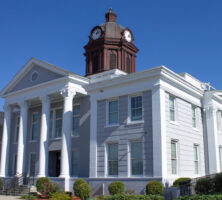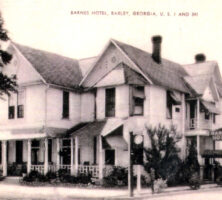Appling County, located south of the Altamaha River in southeast Georgia, was created by an act of the state legislature in December 1818.
The original boundary extended from the Altamaha River to the St. Marys River. Land for the county came from territory ceded by the Creek Indians to Georgia in the 1814 Treaty of Fort Jackson and the 1818 Treaty of the Creek Agency. Appling was named as a posthumous honor for Colonel Daniel Appling of Columbia County, a well-known hero of the War of 1812 (1812-15). Appling was the parent county of all or part of Atkinson, Bacon, Brantley, Charlton, Clinch, Coffee, Echols, Jeff Davis, Pierce, Telfair, Ware, and Wayne counties.
In spite of Appling County’s isolation from more populated sections of eastern Georgia and its location in the pine barrens region of the state, the 1820 census listed 1,264 residents. The population of Appling increased when the General Assembly included the county in the state land lottery drawings for 1820, 1821, 1827, and 1832. Two dominant seed areas of migration into Appling were South Carolina and Tattnall County, Georgia.

In 1819 the General Assembly gave permission to Appling’s inferior court justices to select a site for a county seat. The task rotated to five county commissioners and back to the justices between 1819 and 1828. Disagreements over the location prohibited a final selection until 1828, when the legislature designated Holmesville as the official site.
Appling’s early economic activity consisted primarily of small-scale subsistence farming. Sales of livestock, timber, and naval stores to Darien and Savannah supplemented incomes. Cotton production gained importance during the 1860s and lasted until a lull in production between 1972 and the mid-1980s. Current agricultural enterprises include cotton, tobacco, dairy products, and blueberries, as well as slash and loblolly pine.
The Altamaha River provided a popular avenue for early residents to ship products to coastal towns. During the nineteenth century steamboats and pole boats transported cotton, fertilizer, lumber, turpentine, and local produce. For a time Appling County was known as the turpentine capital of the world. Residents also constructed timber rafts from cut trees destined for the Darien sawmills. These rafts reached proportions of 25 feet wide by 175 feet in length. A unique rafting and turpentine culture grew out of Appling County. In 1982 raft enthusiasts and historians developed Project Raft to remember the culture and skills of that former era.
The completion of the Macon and Brunswick Railroad in 1870 linked Appling to populated regions of the state and prompted the creation of three new towns. Stations 6 and 8 on the railroad became known as Surrency and Graham, respectively. Surrency, named for an 1850s immigrant from Tattnall County, Allen Powell Surrency, gained notice during the early 1900s for its extensive production of railroad crossties. Graham was named for landowner and state representative Middleton Graham. Ongoing complaints that Holmesville lay too far from the center of the county prompted residents in 1874 to move the county seat to the site of a popular store operated by Wilson Baxley near station 7. The new town, named Baxley in honor of the storekeeper, was incorporated by the state legislature in 1875.
Influential citizens of Appling County have included storeowner John Comas, a native of Barcelona, Spain. His grandson Philip H. Comas and H. Clifton McCrackin were influential physicians and political leaders in the county during the late nineteenth and early twentieth centuries. Comas also served in the Georgia senate from 1902 to 1903. Seaborn Hall served in the General Assembly during the 1830s and 1840s, as a delegate to the Georgia Secession Convention of 1861, and as an 1877 delegate to the state constitutional convention. Alfred le Sesne Jenkins worked in Chinese and Asian affairs for the U.S. State Department after World War II (1941-45). He accompanied U.S. president Richard Nixon on his historic visit to China in 1972.
Literary fame came to the county with the 1934 Pulitzer Prize-winning novel by Caroline Miller, Lamb in His Bosom. Miller briefly lived in Baxley while she wrote the novel, and she sought to incorporate the unique cultural activities and language patterns of wiregrass farmers in her work. More recently, Janisse Ray published Ecology of a Cracker Childhood (1999), an account of coming of age in Appling County and a call to preserve the rapidly disappearing ecological environment of the county. In 2003 Ray published a second book, Wild Card Quilt: Taking a Chance on Home, dealing with her decision to return to live in her family’s homeplace in Appling County.
According to the 2020 U.S. census, the population of Appling County is 18,444, an increase from the 2000 population of 17,419. Appling offers a variety of natural recreation sites, including Lake Mayer, the A. Randall Tuten Environmental Park, and Moody Swamp. Altamaha Technical College operates a satellite campus in Baxley.


